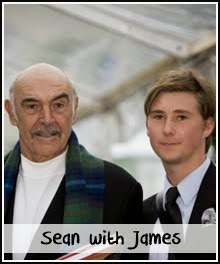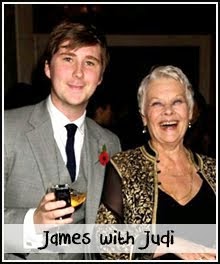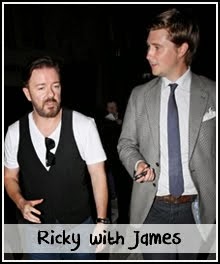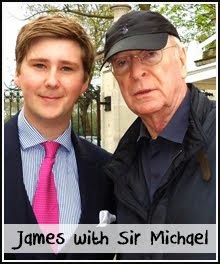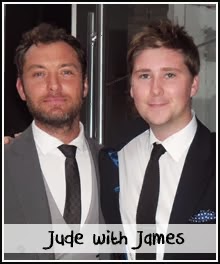Tarsem with James
Sports fans will associate the word ‘googly’ with cricket and, if asked what a ‘googly’ was, they would almost certainly say a type of cricket delivery. This, however, is due to change, as film director Tarsem Singh’s ‘Googly Films’ present his latest picture, ‘The Fall’, bringing a new meaning to the term.
The self-financed film, which I found to be stunning, is a sumptuous, visual spectacle, full of bright vibrant colours. It was shot in a number of countries covering almost every continent, with Tarsem leaving his best camera work to capture Northern India, the Taj Mahal, Udaipur, and several sweeping shots of Jodhpur, ‘the blue city’.
‘The Fall’, which is Tarsem’s second feature film, made its debut at the 2006 Toronto International Film Festival, and is essentially two stories in one.
Alexandria is a young Romanian girl who lives and works in the orange groves of 1920s Los Angeles with her family. After falling and breaking her collarbone, she is taken to hospital and, while convalescing, meets Roy, a paraplegic, suicidal man, who begins to tell her a fantastic story about five mythical heroes or, as he describes it, “an epic tale” of heroes, villains, action and adventure.
Thanks to his hallucinatory state of mind and her vivid imagination, the line between fiction and reality starts to blur as the tale advances, with Alexandria using people she interacts with at the hospital as characters in the story.
Tarsem who began his career directing music videos, including “Hold On” by En Vogue, “Sweet Lullaby” by Deep Forest and the music video for R.E.M.’s smash hit “Losing My Religion”, which won ‘Best Video of the Year’ at the 1991 MTV Video Music Awards, was unable to get funding for the project because he wanted it to be written by a four-year-old.
He explained “All the investors would ask, ‘When will the script be ready?’ and I’d say, ‘Actually the script is going to be written by a 4 year old, so there isn’t a script.’ They didn’t think it would work, so in the end I just said, ok it’s my money and we’ll go off and do it when we find the girl. At that stage I didn’t know if we would or not.”
Travelling from country to country over the next 17 years, provided cricket loving Tarsem with the opportunity to scout for locations that were perfect for, what he called, his “dream project”.
“I had been putting together photographs of locations because I wanted to shoot in a style of filming that I didn’t think had been exposed to too many people. I decided that it was not going to be a piece that was CGI’d (Computer Generated Image), so I had to find all the locations, which took a long time.”
With the suitable and incredibly beautiful back-drops ready to work with, the charming director’s next task was to find the child actress. For 8 years, Tarsem, who once made more money in one day shooting a commercial than his father did in 30 years as an aircraft engineer in India, searched for his ideal star. “I didn’t think there was anywhere on the globe I could find a child that hadn’t been exposed to cinema. Every year I was sending out the casting scout with a camera to pick out a few kids and film them. He would tell them a tale so I could see what their response was like.”
After what seemed an age, Tarsem received this tape from a girl in Romania which, he claims just: “blew me away”.
“I immediately flew to Romania and told my brother, Producer Ajit Singh, ‘We’ve found the girl’. She was six at the time and didn’t speak a word of English, which was perfect because her trying to understand the language made her more natural. The only problem was we now had to find a real location as I didn’t think we could shoot in the studio."
After more searching, Tarsem, a self confessed squash addict, found a lunatic asylum in South Africa, which he decided could double for the hospital. “We took one wing of it and dressed it exactly so I could always explain to her things visually. I would say, ‘you are here, he’s here, you’re bored, you throw this to him.’ In every scene I was telling her things in sequence. The first time she saw him is the first day she sees him in the movie. The second scene is the second time she sees him. So she did write the script.”
During the twelve week shoot, Catinca Untaru, who plays the part of the little girl, was led to believe actor Lee Pace, who portrays the paralysed stuntman, really was unable to walk in order to maintain this illusion to the junior actress. “Everything had to happen that way, because the little girl's magic was required. It wasn't the cliché of a method actor wanting to stay in a wheelchair the whole shoot but, when you're on a film set, no matter how dire a situation you're putting across, when you're on that set for long enough, it gets jokey. I didn't want it to get to a stage where people would walk on Lee's bed, or tell handicap jokes, as I knew it would filter down to the girl, even in body language.”
The director, whose films are renowned for their operatic colourful beauty, deserts, horses, exotic locations, lack of digital animation, extensive costume design and sets, found keeping the secret harder than the exquisite filming itself. “Once I came into it, my immediate thought was, ‘How long can we carry on this façade?’ It was such an audaciously big lie. Lee was caught almost everyday because he went to the gym most mornings. He'd go there and see a number of the crew and, think to himself, ‘Oh my God, I'm caught!’ But they'd walk right by him. They didn’t recognise him out of the wheelchair!”
The chemistry between Catinca and Pace is undeniable, with many of the hospital scenes yielding some poignant footage. “Magic happened between the two of them. I almost decided not to go and shoot any of the fantasy stuff after it happened. I thought it was a complete film.”
But a personal hardship changed the affable director’s mind, “My whole life fell apart after my girlfriend and I separated. I decided to go on a magical mystery tour. I called my brother and I just said, ‘Sell everything. I have no idea if this little light I’m seeing at the end of the tunnel is an oncoming train or what but we’re going in it. If you have to sell the home, call me.’ Four and a half years and 24 countries later I called him and said, ‘I’m almost done.’ He said, ‘The house is almost up for sale,’ so I said, ‘I’m finished.
Tarsem, a graduate of the Art Centre College of Design, in Pasadena, California, says he owes everything to film school. He explained, “They had to use a shovel and an axe to get me out of school. I didn't want to leave, and I would go back in there in a heartbeat. I just absolutely adored and loved it. You have to understand, I'd never held a still camera in my hand before that! They taught me everything. How the damn thing works, where to put it, everything!”
So what’s next for the affable film maker?
“I’ll go where the road takes me: the long, the winding, and the yellow.”
jamesdaviesmedia.com



